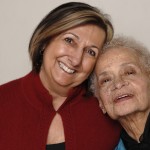The Legacy of Kathy Grant
by Kathy Corey
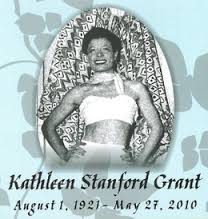 Kathleen Stanford Grant was a dancer and first generation Master Pilates Teacher. She was born August 1, 1921 in Boston Massachusetts. “I think I started to dance in my mother’s womb,” Kathy said, “but growing up, there was not much interest in theater, especially black theater, in Boston.”
Kathleen Stanford Grant was a dancer and first generation Master Pilates Teacher. She was born August 1, 1921 in Boston Massachusetts. “I think I started to dance in my mother’s womb,” Kathy said, “but growing up, there was not much interest in theater, especially black theater, in Boston.”
At the age of nine, she began taking ballet classes at the Boston Conservatory of Music. Because of the prejudicial racial attitudes of that time, she had to go to the conservatory when no other students were there and take private lessons. There were no black dance role models for her to follow and in many ways, dance was still considered “sinful”.
During high school, she spent summers in New York studying ballet at Carnegie Hall. After high school, she moved to New York City and performed on Broadway. She was a chorus girl and dance captain for the Zanzibar Club in Harlem in the 1940s.
Kathy then traveled through Europe to dance with the Claude Merchant Dance Company. There, for the first time, she felt a freedom that she had not experienced in the States. With the lack of racial discrimination, she loved being able to enter restaurants without wondering if it was acceptable for her to do.
In 1953, Kathy returned to New York where she danced with Arthur Mitchell and Donald McKayle. In 1954, after knee surgery, Kathy was referred to Joseph Pilates by dancer Pearl Bailey. After just a few years, she began to teach at Carola Trier’s studio and then later ran the Pilates program at the Henri Bendel department store. At Bendel’s, she taught the store’s affluent patrons, as well as dancers from many companies in New York.
As a student and protégé of Joseph Pilates, she is one of only two people who was certified to teach by Mr. Pilates. Kathy, along with Lolita San Miguel, received her certification from the New York State Vocational Rehabilitation Program in a program that included 2,200 hours of work with Joseph Pilates from 1964 to 1965.
Kathy also served as the Administrative Director at the Dance Theatre of Harlem. She taught a morning class that included the Pilates Mat work and Jazz.
She was the first African-American to join the National Endowment for the Arts panel. She was also on the New York Council of the Arts.
In 1988, she began to teach Pilates at the Tisch School of the Arts at New York University. She trained students, professional and retired dancers, and non-dancers. At Tisch, she developed her vocabulary for students to learn about and strengthen their bodies before doing the Pilates work.
Kathy created her program, Before the Hundred, to prepare the body for the Pilates exercises. She wanted to get the body strong before beginning the program. It was important to her that you knew your body – your own strengths and weaknesses – to prevent injury.
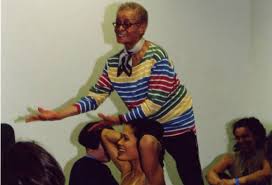 Kathy had a way of explaining her cueing through her “Song”. Her “Song” consisted of a series of images. “Zip Tight Jeans” and “Belly Button To The Lowest Part Of The Waistline” meant connecting into your abdominals. “Put A Belt On” lifted us through our center. “Put A Vest On” was for an elegant occasion and lifted our chests. “Tape Measure” gave us an image of being measured for a dress under your breastbone and brought the ribs in. Once you understood these cues, she would simply say, “zipper”, “vest”, “tape measure” and it was a shortcut to all the cueing you would need to align your body in the exercises.
Kathy had a way of explaining her cueing through her “Song”. Her “Song” consisted of a series of images. “Zip Tight Jeans” and “Belly Button To The Lowest Part Of The Waistline” meant connecting into your abdominals. “Put A Belt On” lifted us through our center. “Put A Vest On” was for an elegant occasion and lifted our chests. “Tape Measure” gave us an image of being measured for a dress under your breastbone and brought the ribs in. Once you understood these cues, she would simply say, “zipper”, “vest”, “tape measure” and it was a shortcut to all the cueing you would need to align your body in the exercises.
Kathy also had a saying, “I want you to move without moving. No matter where you go, you have to remember your center. You don’t do it physically. You do it mentally. You do it from the inside.” This is only one of the many valuable lessons I learned from her.
Kathy knew bodies better than anyone I have ever known in my Pilates career. One day when I was doing her strap work on the Cadillac, she called from across the room, “Put your shoulders down.” She was facing away from me and couldn’t possibly see my body position. “How do you know my shoulders are up?” I asked. “Well they are, aren’t they?” she replied. Of course they were, and I adjusted them. “That’s better,” she said without ever turning around.
That was another lesson from Kathy about knowing your student’s bodies, teaching them to move from the inside, and “seeing movement” as a teacher. Seeing is not about looking at the movement of the exercises. Seeing is about how the body moves from the inside out. Seeing the body is an experience that deepens the relationship between student and teacher. It gives body knowledge on how each person individually performs movement. Seeing transforms a good teacher into a great teacher. It takes time, patience and a willingness to explore your own relationship to your body and mind. It challenges what you know and how you apply your skills. But it deepens your ability as a teacher. Seeing is the most important lesson I have learned and I use it everyday in my teaching and in my life.
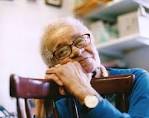 Kathy was a no-nonsense person and a no-nonsense teacher. If you did not take the work seriously, if you did not do your homework, she would be tough on you. But if you really listened and worked the work, she was patient and kind. She loved to share her knowledge of the work and was always exploring new ideas and approaches to movement. She believed you must always be a student of the work and often when I was teaching, she would show up and take class. She said you must learn something every time you teach and you must stay present with your students and with yourself through your teaching.
Kathy was a no-nonsense person and a no-nonsense teacher. If you did not take the work seriously, if you did not do your homework, she would be tough on you. But if you really listened and worked the work, she was patient and kind. She loved to share her knowledge of the work and was always exploring new ideas and approaches to movement. She believed you must always be a student of the work and often when I was teaching, she would show up and take class. She said you must learn something every time you teach and you must stay present with your students and with yourself through your teaching.
Kathy Grant died on May 27, 2010 at the age of 88. She was a pioneer and known for being a great innovator in the Pilates community. She lived a full life as a professional dancer, arts administrator and Master Pilates Teacher. Her work, and her spirit, lives on through the many teachers she taught, and mentored, and to those with whom she shared her knowledge and wisdom. We were privileged to have had her in our lives and with great respect, we honor her every time we teach.
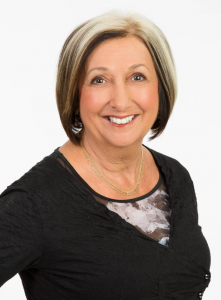 Kathy Corey is a Master Teacher who began her career with the Pilates Technique in 1979. She has been the leading expert in the Pilates community for over 30 years. She is the Director of Kathy Corey Pilates. The Kathy Corey Pilates Certification Program is taught at locations across the United States and her continuing education programs are taught in twenty countries. In 2004, she designed the innovative CORE BandTM, which is used in studios around the world. The Core BandTM Mat Class is recognized as an enhancement to the traditional mat exercises.
Kathy Corey is a Master Teacher who began her career with the Pilates Technique in 1979. She has been the leading expert in the Pilates community for over 30 years. She is the Director of Kathy Corey Pilates. The Kathy Corey Pilates Certification Program is taught at locations across the United States and her continuing education programs are taught in twenty countries. In 2004, she designed the innovative CORE BandTM, which is used in studios around the world. The Core BandTM Mat Class is recognized as an enhancement to the traditional mat exercises.
